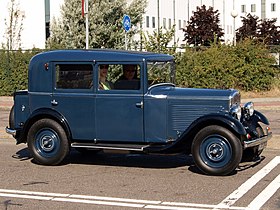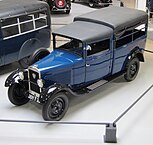| Peugeot 201 | |
|---|---|
 Peugeot 201C Peugeot 201C | |
| Overview | |
| Manufacturer | Peugeot SA |
| Production | 1929–1937 142,309 units |
| Assembly | Sochaux, France |
| Body and chassis | |
| Body style | 4-door saloon other bodies available |
| Layout | FR layout |
| Powertrain | |
| Engine | 1085 cc - 1465cc I4 |
| Dimensions | |
| Wheelbase | 247 cm (97.2 in) |
| Length | 3,800 mm (149.6 in) |
| Width | 1,350 mm (53.1 in) |
| Curb weight | 890 kg (1,962 lb) |
| Chronology | |
| Predecessor | Peugeot Type 190 |
| Successor | Peugeot 202 |
The Peugeot 201 is a car produced by Peugeot between 1929 and 1937.
The car was manufactured at the company's Sochaux plant near the Swiss frontier, and is today celebrated in the adjacent Peugeot museum. Although Peugeot had produced a petrol/gasoline-powered motor vehicle as early as 1886, the Peugeot 201 may reasonably be seen as the company's first mass-produced model.
History
The Peugeot 201 was presented at the 1929 Paris Motor Show with the backdrop of the Wall Street Crash. While many European manufacturers did not survive the ensuing depression, the 201's image as an inexpensive car helped Peugeot to survive the economic crisis with its finances intact and its status as a major auto producer confirmed.
Models
During the 1930s Peugeot offered several variants of the 201, mostly with increasing engine capacity. The exception is the 1085 cc engine in the competition-oriented 201 S and CS. Presented in March 1932, 403 examples were built until July of the same year. The engine's stroke was shortened from 90 to 87 mm (3.54 to 3.43 in), with the 63 mm (2.48 in) bore remaining unchanged; power increased to 30 hp (22 kW).
Initially, the 201 range was powered by a 1122 cc engine developing 23 hp (17 kW) at 3500 rpm (top speed: 80 km/h / 50 mph). This was followed by a 28 hp (21 kW) engine of 1307 cc in September 1934, when the revised 201 D (and the longe wheelbase DL light truck derivative) were introduced. The D models also benefitted from a fully synchronized transmission. The final development was when the 201 M was presented in August 1936. This model was not a 201 per se, it was a decontented version of the recently discontinued 301. At the same time, that model was replaced by the new 302. The 201 M kept the 301's 1465 cc unit of 35 hp (26 kW) and could reach a claimed top speed of 100 km/h (62 mph).
The Peugeot 201 C, launched in 1931, is claimed to be the first mass-produced car equipped with independent front suspension, a concept rapidly adopted by the competition. The simpler beam front axle version remained available, but the optional independent suspension system reportedly improved road holding and reduced steering column vibration.
-
 The 201 was typical of many western European family saloons in that during the 1930s the standard body was redesigned to incorporate new ideas about streamlining.
The 201 was typical of many western European family saloons in that during the 1930s the standard body was redesigned to incorporate new ideas about streamlining.
-
 Interior
Interior
Naming
In the early twentieth century, car manufacturers paid little attention to the naming of their vehicles. The 201's predecessor, the Type 190, is so named because it was the 190th distinct design developed by Peugeot. However, at the time few customers would have been aware of the name "Type 190". Even in the company's own brochures, the car now known as the Type 190 was simply called "La 5CV Peugeot" (The Peugeot 5 hp).
For Peugeot, a new naming scheme was introduced when the Type 190 was replaced by Peugeot 201. The 201 was the first Peugeot to carry a name comprising three numerals with a central zero, a naming scheme continued with the 301 and 401. Peugeot took effective steps to protect all such automobile names, to the discomfiture of Porsche in the 1960s as they prepared to launch their new 901 model. Curiously, the name of the Ferrari 308 was not a problem.
Light commercials
Between 1931 and 1933 the company produced 1,676 commercial versions of the 201, aimed at small shopkeepers and other businessmen. A wide range of body types was produced including a flatbed truck, a "bakers' van" and light vans with and without side windows behind the B-pillar.
Sources
- "1929 : 201". peugeot.com. Archived from the original on 2012-02-06. Retrieved 2008-03-17.
- "Automobilia". Toutes les Voitures Françaises 1932 (salon 1931): Comme tous constructeurs français, Peugeot souffre de la dépression économique mondiale et ses cadences de production s'effondrent. Malgré ce ralentissement sensible de son activité en 1932, Peugeot traverse la crise sans trop de dommages grâce à la 201 dont le caractère économique devient un argument déterminant dans cette période difficile. Vol. 80s. Paris: Histoire & collections. 2006. p. 74.
- "Le Restauration Peugeot 201 BR3". Voitures Anciennes Photos et Fiches Techniques (in French). Archived from the original on 2024-02-25.
- Musée de l'Aventure Peugeot. The exhibit label (2012) states: « Jusqu'à présente le modèles Peugeot se suivaient dans une numérotation plus ou moins logique qui d'ailleurs n'était que peu utilise par la publicité. Par exemple le 190 S était présenté dans les brochures sous le nom « Le 5 CV Peugeot ». Avec la 201 une ère novelle commence.»
- Auto passion, nbr 37, juillet 1990
- Rétro hebdo, nbr 28, septembre 1997
- Rétroviseur ISSN 0992-5007, nbr 58
| Peugeot road vehicle timeline, 1889–1944 — next » | |||||||||||||||||||||||||||||||||||||||||||||||||||||||||||||||||||||||||||||||||||||||||||||||||||||||||||||||||||||||||||||||||||||||||||||||||||||||||||||||||||||||||||||||||||||||||||||||||||||||||||||||||||||||||||||||||||||||||||||||||||||||||||||||||||||||||||||||||||||||||||||||||||||||||||||||||||||||||||||||||||||||||||||||||||||||||||||||||||||||||||||||||||||||||||||||||||||||||||||||||||||||||||||||||||||||||||||||||||||||||||||||||||||||||||||||||||||||||||||||||||||||||||||||||||||||||||||||||||||||||||||||||||||||||||||||||||||||||||||||||||||||||||||||||||||||||||||||||||||||||||||||||||||||||||||||||||||||||||||||||||||||||||||||||||||||||||||||||||||||||||||||||||||||||||||||||||||||||||||||||||||||||||||||||||||||||||||||||||||||||||||||||||||||||||||||||||||||||||||||||||||||||||||||||||||||||||||||||||||||||||||||||||||||||||||||||||||||||||||||||||||||||||||||||||||||||||
|---|---|---|---|---|---|---|---|---|---|---|---|---|---|---|---|---|---|---|---|---|---|---|---|---|---|---|---|---|---|---|---|---|---|---|---|---|---|---|---|---|---|---|---|---|---|---|---|---|---|---|---|---|---|---|---|---|---|---|---|---|---|---|---|---|---|---|---|---|---|---|---|---|---|---|---|---|---|---|---|---|---|---|---|---|---|---|---|---|---|---|---|---|---|---|---|---|---|---|---|---|---|---|---|---|---|---|---|---|---|---|---|---|---|---|---|---|---|---|---|---|---|---|---|---|---|---|---|---|---|---|---|---|---|---|---|---|---|---|---|---|---|---|---|---|---|---|---|---|---|---|---|---|---|---|---|---|---|---|---|---|---|---|---|---|---|---|---|---|---|---|---|---|---|---|---|---|---|---|---|---|---|---|---|---|---|---|---|---|---|---|---|---|---|---|---|---|---|---|---|---|---|---|---|---|---|---|---|---|---|---|---|---|---|---|---|---|---|---|---|---|---|---|---|---|---|---|---|---|---|---|---|---|---|---|---|---|---|---|---|---|---|---|---|---|---|---|---|---|---|---|---|---|---|---|---|---|---|---|---|---|---|---|---|---|---|---|---|---|---|---|---|---|---|---|---|---|---|---|---|---|---|---|---|---|---|---|---|---|---|---|---|---|---|---|---|---|---|---|---|---|---|---|---|---|---|---|---|---|---|---|---|---|---|---|---|---|---|---|---|---|---|---|---|---|---|---|---|---|---|---|---|---|---|---|---|---|---|---|---|---|---|---|---|---|---|---|---|---|---|---|---|---|---|---|---|---|---|---|---|---|---|---|---|---|---|---|---|---|---|---|---|---|---|---|---|---|---|---|---|---|---|---|---|---|---|---|---|---|---|---|---|---|---|---|---|---|---|---|---|---|---|---|---|---|---|---|---|---|---|---|---|---|---|---|---|---|---|---|---|---|---|---|---|---|---|---|---|---|---|---|---|---|---|---|---|---|---|---|---|---|---|---|---|---|---|---|---|---|---|---|---|---|---|---|---|---|---|---|---|---|---|---|---|---|---|---|---|---|---|---|---|---|---|---|---|---|---|---|---|---|---|---|---|---|---|---|---|---|---|---|---|---|---|---|---|---|---|---|---|---|---|---|---|---|---|---|---|---|---|---|---|---|---|---|---|---|---|---|---|---|---|---|---|---|---|---|---|---|---|---|---|---|---|---|---|---|---|---|---|---|---|---|---|---|---|---|---|---|---|---|---|---|---|---|---|---|---|---|---|---|---|---|---|---|---|---|---|---|---|---|---|---|---|---|---|---|---|---|---|---|---|---|---|---|---|---|---|---|---|---|---|---|---|---|---|---|---|---|---|---|---|---|---|---|---|---|---|---|---|---|---|---|---|---|---|---|---|---|---|---|---|---|---|---|---|---|---|---|---|---|---|---|---|---|---|---|---|---|---|---|---|---|---|---|---|---|---|---|---|---|---|---|---|---|---|---|---|---|---|---|---|---|---|---|---|---|---|---|---|---|---|---|---|---|---|---|---|---|---|---|---|---|---|---|---|---|---|---|---|---|---|---|---|---|---|---|---|---|---|---|---|---|---|---|---|---|---|---|---|---|---|---|---|---|---|---|---|---|---|---|---|---|---|---|---|---|---|---|---|---|---|---|---|---|---|---|---|---|---|---|---|---|---|---|---|---|---|---|---|---|---|---|---|---|---|---|---|---|---|---|---|---|---|---|---|---|---|---|---|---|---|---|---|---|---|---|---|---|---|---|---|---|---|---|---|---|---|---|---|---|---|---|---|---|---|---|---|---|---|---|---|---|---|---|---|---|---|---|---|---|---|---|---|---|---|---|---|---|---|---|---|---|---|---|---|---|---|---|---|---|---|---|---|---|---|---|---|---|---|---|---|---|---|---|---|---|---|---|---|---|---|---|---|---|---|---|---|---|---|---|---|---|---|---|---|---|---|---|---|---|---|---|---|---|---|---|---|---|---|---|---|---|---|---|---|---|---|---|---|---|---|---|---|---|---|---|---|---|---|---|---|---|---|---|---|---|---|
| |||||||||||||||||||||||||||||||||||||||||||||||||||||||||||||||||||||||||||||||||||||||||||||||||||||||||||||||||||||||||||||||||||||||||||||||||||||||||||||||||||||||||||||||||||||||||||||||||||||||||||||||||||||||||||||||||||||||||||||||||||||||||||||||||||||||||||||||||||||||||||||||||||||||||||||||||||||||||||||||||||||||||||||||||||||||||||||||||||||||||||||||||||||||||||||||||||||||||||||||||||||||||||||||||||||||||||||||||||||||||||||||||||||||||||||||||||||||||||||||||||||||||||||||||||||||||||||||||||||||||||||||||||||||||||||||||||||||||||||||||||||||||||||||||||||||||||||||||||||||||||||||||||||||||||||||||||||||||||||||||||||||||||||||||||||||||||||||||||||||||||||||||||||||||||||||||||||||||||||||||||||||||||||||||||||||||||||||||||||||||||||||||||||||||||||||||||||||||||||||||||||||||||||||||||||||||||||||||||||||||||||||||||||||||||||||||||||||||||||||||||||||||||||||||||||||||||
